ISSN: 1204-5357
ISSN: 1204-5357
| Falaye Adeyinka Adesuyi Lecturer, Department of Mathematics/Statistics, Federal University of Technology Minna, Nigeria Postal Address: P.M.B 65 Minna Niger State Nigeria Author's Personal/Organizational Website: www.futminna.edu.ng Email: falaye.adeyinka@futminna.edu.ng Falaye holds B.Tech (Mathematics/Computer Sc.) and M.Sc. (Computer Sc.). He is a member of National mathematical Society (NMS) as well as Nigeria Computer Society (NCS). His areas of interest are risk management and security in Network Systems, mobile and internet banking. |
| Adepoju Adelowo Solomon Lecturer, Department of Computer Science, Federal University of Technology, Minna, Nigeria Postal Address: P.M.B 65 Minna Niger State Nigeria Author's Personal/Organizational Website: www.futminna.edu.ng Email: solomon.adepoju@futminna.edu.ng Adepoju holds B.Tech (Mathematics /Computer Science) and M.Sc. (Computer Science). He is a member of Computer Professional Registration Council of Nigeria (CPN). His areas of interest are Usability evaluation, Human Computer Interaction and Information Technology Impact on Society |
| Yakubu David Robert Research Fellow, Department of Mathematics and Statistics, Federal University of Technology Minna, Nigeria Postal Address: PMB 65 Minna Niger State Author's Personal/Organizational Website: www.futminna.edu.ng Email: Infodyr@gmail.com Robert holds B.Tech in Mathematics/Computer Science. His research interest is mobile and internet banking. |
| Oludare Isiaq Alabi Lecturer, Department of Information and Media Technology, Federal University of Technology Minna, Nigeria Postal Address: P.M.B 65 Minna Niger State Nigeria Author's Personal/Organizational Website: www.futminna.edu.ng Email:Isiaq.alabi@yahoo.co.uk Alabi is an industry-experienced IT professional and an academic. He holds. B.Sc (Computer Science) and Master in Information Technology. His interest is data mining. |
Visit for more related articles at Journal of Internet Banking and Commerce
This research work reviews the current practices in Nigeria’s customer banking services with an empirical investigation into ATM fraud as well as a physical and technical implementation of security. The survey was conducted using questionnaire as the research instrument. Four hundred 400 questionnaires were distributed among Entrepreneurs, Civil servants and Students from four states of the federation namely Lagos, Abuja, Kaduna and Jos. Three hundred and twenty seven (327) were retrieved successfully while three hundred and three (303) were properly responded. The data collected was analyzed using Chi-Square test and one way ANOVA. The results obtained shows there is no statistically significant difference in the perception of entrepreneurs, civil servants and students on the positive impact of ATM on banking. The perceptions of the three variables on security challenges of ATM services are equal. It was concluded in the research that the current security implementation does not proffer the adequate security necessary to secure electronic transactions, customers’ information and funds.
Keywords |
| Secured, ATM, Transaction, Biometrics, Authentication |
INTRODUCTION |
| The continuous advances in internet technology characterized by a complex and competitive environment have brought huge impact on business operations and have in particular brought about a paradigm shift in banking operations. In a bid to catch up with global development, improve the quality of service delivery, and reduce cost of transactions, the application of information and communication technology concepts, techniques, policies and implementation strategies to banking services is now a subject of fundamental necessity and concern to all banks and indeed a prerequisite for local and global competitiveness in Banking. |
| The Nigerian banking industry experienced a consolidation exercise that left Nigeria with 25 banks out of 89 banks previously in existence. In a bid to ensure customer satisfaction in the post consolidation era, banks have invested greatly in the development of their Information Technology (IT) infrastructure. |
| The last decade witnessed all banks transform from manual to automated systems involving the use of various e-banking and e-payment systems for delivering a wide range of value-added products and services. |
| In 2008, the adoption of e-payment systems within the Nigerian banking structure accounted for N360 billion worth of transactions. From Interswitch statistics, Nigeria currently has about 9000 ATM terminals installed across the Federation that serve 30million ATM users and accounts for 100 million transactions monthly. |
| With gradual growth levels since its introduction in 1990, the use of ATMs in Nigeria has been explosive in recent years with transaction volumes growing from 1.6 million transactions in 2006 to over 500 million transactions in 2009 (year to date). The number of ATMs has also grown from just over 500 ATMs in 2006 to over 8000 ATMs in 2009 (Launce, 2010). However the industry has also witnessed considerable increase in the number of attempted or successful fraud perpetrated as well as the volumes of losses accruing to banks as well as their respective customers. |
| According to the CBN Annual Report and Financial Statements (2008), there were a total of 1,974 reported cases of attempted fraud and forgery, involving N24.5 billion, US$1.4 million, €451,075.0 and £2,635.00 compared with 1553 reported cases involving N8.8 billion, US $591,487.8, €35,390.8 and £12,410.0 in 2007. |
| Out of this number, 746 cases were successfully executed by the perpetrators and resulted in losses to the banks amounting to N6.4 billion, US$175,594.3 and £2585.0 compared with 825 cases involving N2.7 billion, US$238,621.5, €390.0 and £12,410.0 in 2007. In 2009, complains received for attempted or successful financial crime in Nigeria banking sector sprang up. |
| Though losses incurred reduced significantly, 3,852 fraud cases were recorded involving N33.3 Billion. From these reported cases, 1,590 out of 3,852 fraud incidences caused losses of N4.1 Billion on banks’ turnover with seventy percent (70%) of the frauds perpetrated electronically (Haruna, 2011). |
| The Central Bank of Nigeria in attempt to curb these frauds placed cash withdrawal ceiling at N150, 000:00 and N1, 000,000:00 for individuals and organizations respectively with effect from 1st of Jun 2012. This is aimed at cashless society where transactions are to be done through electronics means in line with global practice; Depositors and investors will certainly have to embrace electronic transactions. |
| However, all efforts made by the Apex bank as well as other relevant stake holders including security agencies have only reduced the number of cases as well as the volume of losses; a lasting solution to ATM fraud is yet to be arrived at. The scenario is better represented in Fig. 1, Fig. 2 and Fig.3 below as provided by Financial institution Training Center (2007) |
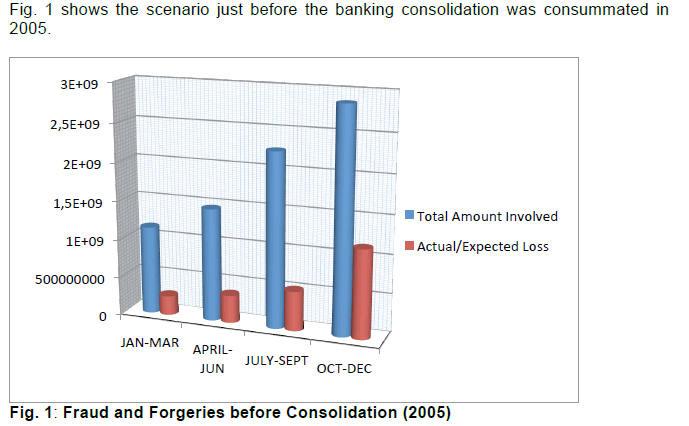 |
| Fig. 2 shows the situation after the consolidation. Although there was a drastic reduction in the figures when compared to 2005, it was only temporary probably as a result of the consolidation. The fraudsters might have taken their time to study situations under the new dispensation before launching attack. |
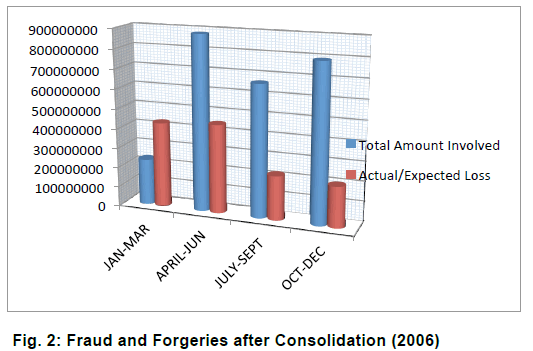 |
| From Fig. 3, one would observe that things have settled down and the figures have increased astronomically |
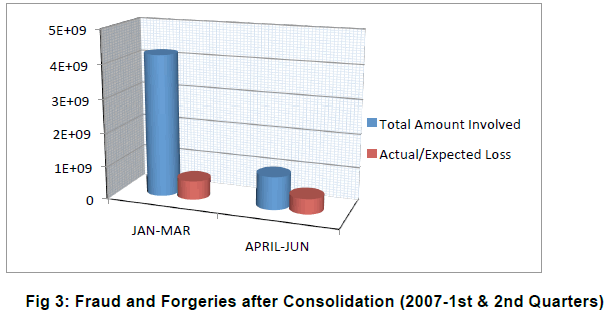 |
| This study assess the impact of ATM on banking with its current security implementation aimed at proffering an efficient ATM security implementation that has zero tolerance for forgery, theft and other forms of ATM fraud. |
| In view of this, the study will equip bank executives, policy makers of the banks and financial institutions and indeed security agencies with necessary information on ATM as a form of electronic banking with a view to making strategic decisions that would enhance effective product delivery to meet customer satisfaction, secure banking operations and improve bank efficiency in general. |
LITERATURE REVIEW |
| The banking industry since the mid-1990s has witnessed a fundamental shift in banking delivery channels toward using self-service channels such as electronic banking, mainly the use of Automated Teller Machines (ATMs) and internet banking. Whereas e-banking stormed the British Banking scene in the late sixties, Nigeria started the long and tortuous journey in November, 1990 when Societe Generate bank launched their first Automated Teller Machine (Adewuyi, 2011). Most Nigerian banks embraced its use after the 2005 banks’ consolidation. Today, there is hardly any bank in Nigeria without the ATMs. |
| According to Peter et al (2008), an ATM combines a computer terminal, record keeping system, and cash vault in one unit, permitting customers to enter a financial firm’s bookkeeping system with either a plastic card containing a Personal Identification Number (PIN) or by punching a special code number into a computer terminal linked to the financial firm’s computerized records 24 hours a day |
| Idowu (2005) outlined the following as the reasons for adoption of e-banking in Nigeria; To the bank it includes: Facilitation of decision making, availability of essential information at finger tips, Improved service delivery, New product development, Savings in space and running costs, Relevance among league of global financial institution. |
| To the customer they are: Quality services are enjoyed, Great reduction in time being spent in banking halls, Confidentiality, Bank statement, balance etc. obtained at ease, 24/7 service delivery and Account could be accessed almost anywhere in the world. While to the economy: Creation of jobs and specialization, Improvement in commerce, Technological development, Data bank for National planning |
| Qureshie et al (2008) is of the opinion that clients shifted from traditional banking to online banking system. The core reason of this transfer is perceived usefulness, perceived ease of use, security and privacy provided by online banking. |
| Despite the potential benefits of ATM as outlined above, the security of e banking especially ATM has been the concern of many bank customers since its introduction in Nigeria. Interestingly, there is growing interest among researchers as regards the issue of ATM security, since it is the most common form of ebanking services that is readily used by bank customers especially in developing countries (Adepoju &Alhassan, 2010; Adesina & Charles 2010; Anthony & Princewill,2011;Charles & Ukpere, 2010; Chris,2006; Christoslav et al 2003; Ezeoha,2005; Steve 2002; Al Sawalqa, 2012) |
| Isaca (2007) highlighted that the key to controlling transaction risk lies in adapting effective policies, procedures, and controls to meet the new risk exposures introduced by e-banking. Basic internal controls including segregation of duties, dual controls, and reconcilements remain important. |
| Information security controls, in particular, become more significant requiring additional processes, tools, expertise, and testing. Institutions should determine the appropriate level of security controls based on their assessment of the sensitivity of the information to the customer and to the institution and on the institution’s established risk tolerance level. |
| Al Sawalqa (2012) in his study assesses the effect of low cost services, security and privacy and ease of use on customers’ financial needs satisfaction of Automatic Teller Machines (ATMs) in Jordan. It was found that only privacy and security contributes significantly to the customers’ financial needs satisfaction. |
| Aderonke and Charles (2010) in their paper discovered that network security and the security of the system in terms of privacy are the major concerns of the users and constitute hindrance to intending users of ATM. This is also attested to by Ezeoha (2005) who from investigation discovered that customers are afraid of security issues as it related to ATM. |
| Alao (2009) in his report is of the opinion that he colossal amount of money lost in Nigeria to ATM fraud through ATM card cloning, PIN theft among others. Hence government had resorted to removing ATM from public places as well as installing security cameras at the ATM locations to track the activities of fraudsters. |
| Adepoju & Alhassan (2010) also discovered in their study on ATM fraud on challenges of ATM Usage and fraud occurrence in Nigeria discovered that no so many security tools are adequately put in place by some banks as regards the use of ATM. |
| Charles & Ukpere (2010) also reported that ATM is the most widely used e payment system in Nigeria and identify identity theft as the most prominent problems hindering the wider adoption of e Banking. Hence they proposed a unified (single) smart cardbased ATM card with biometric-based cash dispenser for all banking transactions. This according to them is to reduce the number of ATM cards carried by an individual and the biometric facility is to introduce another level of security in addition to the PIN which is currently being used |
| Nwaze (2009) in his opinion affirms that since it is an established fact that no bank fraud succeeds without the active support, collaboration or connivance of staff, it is better to understand the kind of staff that one is working with. |
| Komolafe (2010) stated that the CBN came up with a directive in late 2009 barring banks from deploying ATMs outside their locations and those who already have such machines outside their locations were given up to 31st March, 2010 to redeploy such machines to their locations. The purpose of the move by the Apex bank was to make it easier for the respective banks to monitor ATM usage. |
| Moreso, the ‘go cashless’ campaign presently raising awareness in the Nigeria banking sector has opened doors for biometric authentication of customer transactions (Iyawe, 2010). |
RESEARCH QUESTIONS |
| The study would provide answers to the following questions: |
| 1. Has the adoption of ATM in banking operations enhanced the efficiency and reliability of banks and banking? |
| 2. Does Electronic banking improve bank-customer relationship? |
| 3. What are the technical and operational challenges facing the adoption of ATMs in Nigeria? |
| 4. Is the timing right for the adoption of Electronic banking within the Nigerian banking industry? |
RESEARCH HYPOTHESIS |
| For the purpose of the research, the following hypotheses were formulated: |
| H01: There is no statistically significant difference in the perception of entrepreneurs, civil servants and students on the positive impact of ATM on banking. |
| H02: There is no statistically significant difference in the views of entrepreneurs, civil servants and students on the efficiency of the current security implementation of ATMs. |
RESEARCH METHODOLOGY |
| The researchers, in conducting the study made use of survey method with questionnaire as the research instrument. The questionnaire was distributed among Entrepreneurs, Civil servants and Students across four (4) of the major cities of the federation comprising Lagos, Abuja, Kaduna and Jos. From the four hundred (400) questionnaires distributed, three hundred and twenty seven (327) were retrieved successfully and three hundred and three (303) were accepted while twenty four (24) did not capture relevant information required for this research. |
| The questionnaire was designed to capture customers’ ATM operational culture, banks’ performance ratings on ATM services as well as the functional and Security implementation credence of ATMs and ATM services. Sundry opinion poll questions related to ATM were asked comprising of “Yes or No” questions as well as “Agreed, Disagreed or Undecided questions”. The data retrieved were presented using tables and graphs and analyzed using Chi-square test and Analysis of Variance (ANOVA) test on SPSS for windows (version 16). |
ANALYSIS AND DISCUSSION OF RESULTS |
| Table 1 shows the demographic data collected from the field among civil servants, entrepreneurs and students. Table 2 describes the common practice of bank customers as regards ATM usage and banking in general. Table 3 describes customer experiences as regards banks’ role in ATM operations while Table 4 presents the opinions of the respondents on the Functional and Security credence of ATM operations. |
| From Table 2, 95.4% of the respondents operate the ATM for their transactions as against 4.6% who do not. While 15.5% prefer transactions over the counter, 78.5% prefer ATM mode of transaction with just under 16% remaining undecided. |
| As regards convenience of use of ATMs, 253 respondents find it user friendly making up 83.5%. On Online banking, shows that 51.5% of the respondents operate the system of banking while 48.5% do not |
| On personal security consciousness, the study as in Table 2 shows that 63.7% of the respondents have their ATM cards with them at all times with 36.3% having their ATM cards with them only when withdrawals are to be made. 53.8% share their ATM cards with second parties while 43.6% do not. The table further shows that 67% observe security measures while transacting at ATM terminals while 31% do not. |
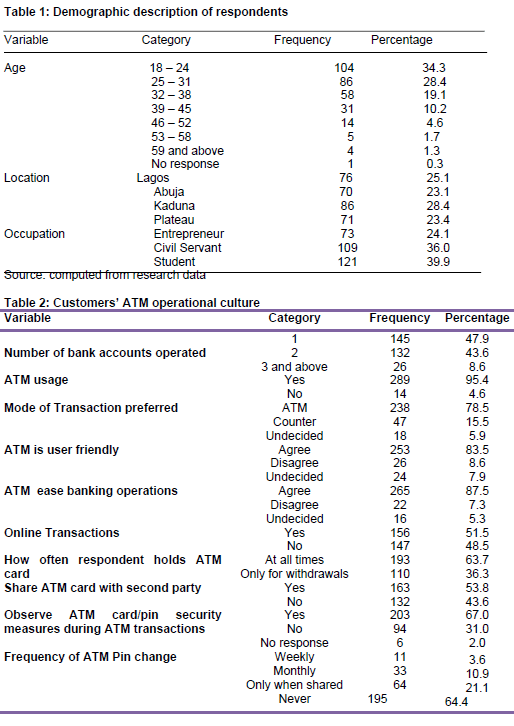 |
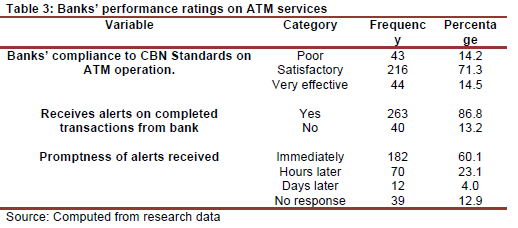 |
| On Banks’ compliance to CBN Standards on ATM operation, Table 3 shows 14.2% perceive it as poor, 71.3% perceive it as satisfactory while 14.5% perceive it as very effective. 86.8% receive alerts on financial transactions from their respective banks while 13.2% don’t. With 60.1% who receive alerts immediately, 23.1% receive theirs hours later, 4.0% receive theirs days later while 12.9% did not respond. |
| As shown in Table 4, as against 57.1% who haven’t, 42.9% of the respondents have been targets of phishing, 41.6% have been victims of ATM card theft while 58.4% haven’t. While 73.3% have experienced at least one form of ATM complication, 23.1% haven’t and 3.6% did not respond. Of the 50.2% who have experienced illegal deductions on their accounts, 83% reported such cases to their respective banks with only 57% confirming the cases resolved by their respective banks. Table 4 further shows that while 39.3% disagree that Pin authentication does not provide adequate ATM security, 51.5% agree with 9.2% remaining undecided. |
| On Biometric technology, Table 4 shows that 62.7% agree that its adoption will proffer better security than Pin authentication, 6.6% disagree while 30.7% remained undecided. On Biometric Technology awareness, Table 3 also shows that 39.3% are aware while 60.7% are not. On the other hand, 85.1% will welcome the adoption of Biometric technology as a means of security while 14.9% would not. |
| Recall the research hypotheses: |
| H01: There is no statistically significant difference in the perception of entrepreneurs, civil servants and students on the positive impact of ATM on banking. H02: There is no statistically significant difference in the views of entrepreneurs, civil servants and students on the efficiency of the current security implementation of ATMs |
| Chi-square test and One way ANOVA were used to analyze the data and result is shown in Table 5, Table 6, Table 7 and Table 8. |
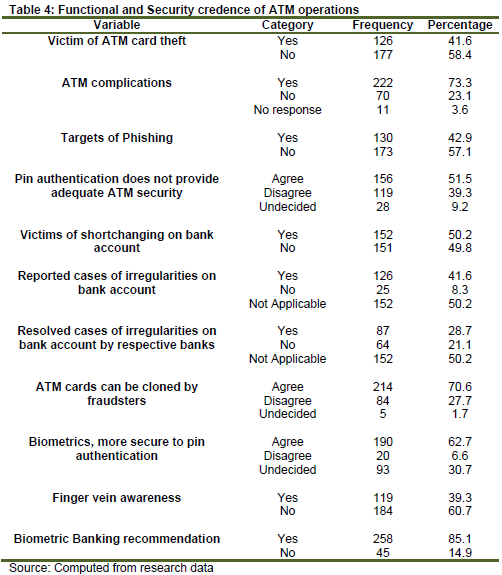 |
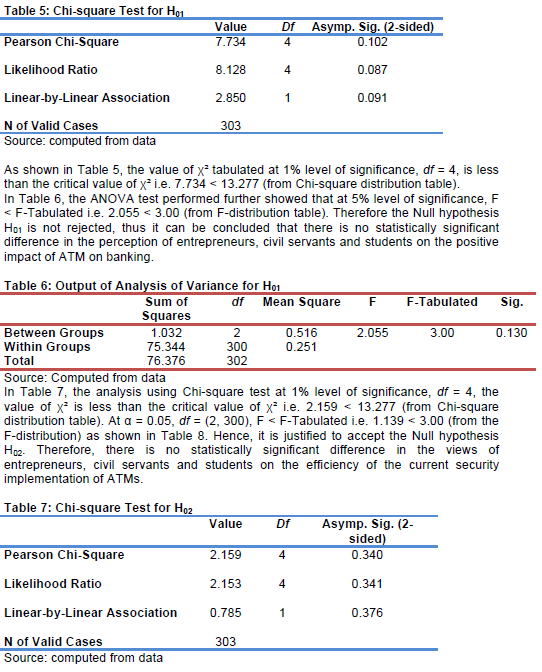 |
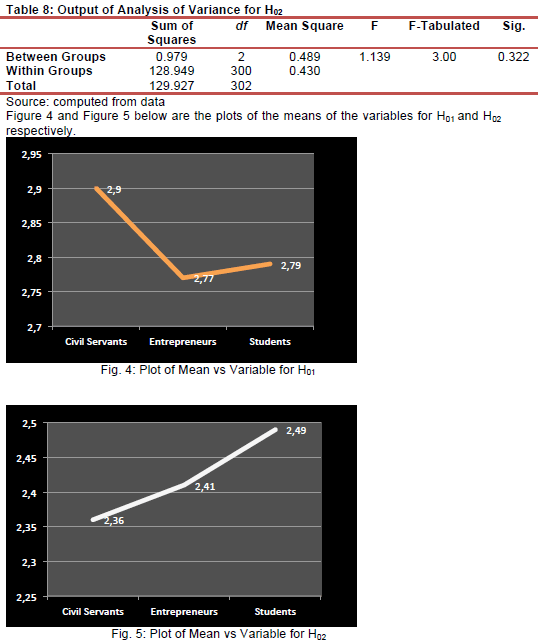 |
| The Null hypotheses (H01 and H02) are further confirmed in Figure 4 Figure 5 which is the plot of mean of the variables since the means are approximately on the same level. |
CONCLUSION |
| The adoption of ATM and its related services within the Nigerian banking premise has been critical on improved efficiency of banking services as well as overall service delivery. Electronic banking has improved the bank customer relationship by rendering effective services throughout the week. Customers can now have access to their accounts outside working hours to make withdrawal to attend to their needs. However, this research discovers that the existing security infrastructure on ATMs is not adequate enough to combat the evolving nature of ATM fraud, hence the need for improved technology on security. |
| Also, the security measures adopted by some banks are obsolete, thus making the measures less significant and allowing fraud at ATM. Standards and Guidelines on Electronic banking lack adequate follow-up as these Standards and Guidelines are unduly breached by some financial institutions. With the introduction and maintenance of a more secure and reliable system and proper policy implementation, cashless society is very much viable within the Nigerian banking industry. |
| The current security implementation does not proffer the adequate security necessary to secure electronic transactions, customers’ information and funds. It is therefore suggested that future work be done on the technical implementation of a more secured authentication method such as finger vein technology and facial recognition. |
References |
|
Copyright © 2025 Research and Reviews, All Rights Reserved